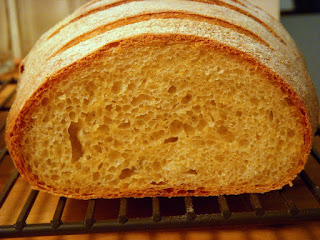After a week and a half of getting settled at the new apartment the various ducks were finally in their respective rows, and I was able to get back to baking! The formula on the docket, Corn Bread, but I would wager this:
-
-
isn't the image that comes to mind when you hear that title. No 9x9 casserole pan quick bread, nor chili to pair it with. Though admittedly I am quite fond of the ol'e standby cornbread it's similarities to this recipe are limited to name and the presence of this stuff,
-
-
yellow cornmeal. As you can see from the picture above I've taken to storing my additions (and small quantity specialty flours) in mason jars. They are cheap, easy to clean, airtight, and surprisingly pretty when filled and set out on the baker's rack we use as our pantry.
-
-
Though the cornmeal only constitutes 25% of the total flour in this bread, it still has a striking impact on the development of the dough, as well as the texture of the crumb in the final product. The reason for this is that even a fine grind of cornmeal like what you see above has a jagged texture. Even after soaking or cooking it maintains that texture to some degree.
The formula asks for 15 minutes of soak time for the cornmeal alone. As this uses the full water content of the final bread, I used substantially cooler water to account for it warming over time. I had a bit of a slip up (in retropsect) when I waited to add the olive oil until after the end of the autolyse. Even though I had the poolish to add at that point, the oil greased down the works and slowed the incorporation to a crawl. After watching it spin merrily around in the bowl for about 20 seconds I decided it would be faster if I went about it the old fashioned way and finished the incorporation by hand.
My own mistakes aside, the cornmeal really made its presence known during the mix cycle. The sharp edges of the granuals have a tendency to puncture the gluten network and slow it's development. This can be counteracted by additional mixing time, and by additional folds during the bulk fermentation. I opted for both of these strategies, and still the dough was a bit slack when it came time for shaping. The end results were pretty solid however.
-
-
To achieve this look I put some flour in a sieve and dusted the top of the loaf at the end of it's bench proofing, just before slashing it with a straight lame. The effect is striking, though admittedly I may have been a bit overzealous on the flouring front :).
-
-
The flour present on this loaf was just the flour used on it before putting it in the proofing basket. The coiled ridges in the basket trap extra flour in them however, which results in the pretty spiral pattern you see on many of my loaves.
-
-
Here, of course, is the crumb. You can't see it well in this picture, but the yellow of the cornmeal appears sporadically throughout the loaf.
Here are the details from the bake:
Room Temp: 75.9
Water Temp: 61
Flour Temp: 73.8
Preferment Temp: 77.5
Final Temp: 77.7 (target 76)
Autolyse: 10 min cornmeal soaking alone, 10 min with breadflour
Mix: long incorporation + 3 minutes at speeed 2, cut on bench, 3 minutes at speed 2, cut on bench, 4 minutes at speed 3
Bulk Fermentation: 1.5 hours with 3 folds after 20, 40, and 60 minutes
Bench Proof: shape, 15minute rest, shape, 45 minute bench proof with the boule spending ~35 minutes each in the fridge to retard development
Bake: ~35 minutes @ 460 degrees
Steam: Steamer used pre-load and for ~45 seconds post load on first loaf, and 1.5 minutes for second
All in all it was a good bread to start with at my new apartment. Be on the lookout, I'll be doing one or two more breads with yeasted preferments (which is all I have done so far) before moving on to sourdough breads. Thanks as always for reading!
-Vino






Now make some chili to go with this. :-)
ReplyDelete